- Submissions

Full Text
Research & Development in Material Science
Potential of Utilizing Coir, Straw, and Recycled PET Fibres as Sustainable & Economical Alternative in Fibre Reinforced Concrete
Hafiz Muhammad Nadir1, Ash Ahmed2*, Parneet Paul3 and Mark Mitchell4
1Researcher, Civil Engineering Group, Leeds Beckett University, UK
2Associate Professor (Reader), Civil Engineering Group, Leeds Beckett University, UK
3Professor and Head of Engineering, Department of Engineering, School of Built Environment, Engineering and Computing, Leeds Beckett University, UK
4Technical Director, Adfil Construction Fibres, Hull, UK
*Corresponding author: Ash Ahmed, Associate Professor (Reader), Civil Engineering Group, Leeds Beckett University, UK
Submission: March 21, 2022;Published: April 13, 2022

ISSN: 2576-8840 Volume 16 Issue 5
Abstract
Researchers have been working on formulating Fibre Reinforced Concrete (FRC) composites that are economical, eco-friendly, and waste absorbent. Incorporating agricultural/ industrial waste into the construction industry as fibre-reinforced composites is a novel research field that can recycle and convert waste into valuable supplementary materials. In this study, concrete composites with fibres of coconut coir (COF), wheat straw (WSF), and shredded fibres from waste plastic bottles (PETF) were evaluated and compared against the established use of polypropylene fibres (PPF) and steel fibres (SF). The study’s objectives were set to attain the strength of 32-40MPa (C32/40 European grade) for using these waste fibres as alternatives in FRC. A concrete mix ratio of 1:2:3 with 1-2% waste fibres (COF & PETF), 1-2% PPFC and 10% & 17% steel fibres were used to produce cubes, cylinders, and prisms for testing on 7 and 28 days for evaluation of compressive, split tensile and flexural strengths. Generally, all FRC mixes with 1% fibre dosage exhibited an increase of compressive strength by 9-44% at 28 days of curing. All fibre composites gave characteristic compressive strength of 40-60MPa. The split tensile strength of all-fibre composites was improved up to 48% with 1-2% fibres. The flexural strength of all-fibre composites improved by 11-42% with 1% fibre and 10% steel fibre but increased fibre’s quantity to 2% and steel fibre to 17% reduced the flexural strength suggesting that fibre content should not exceed more than 2% of cement weight in composites. Shredded fibres of PET plastic bottles outperformed the established micro/macro PPF as PETF exhibited better flexural strength than PPF with both 1 and 2% dosages. The natural fibres of coir/ wheat straw gave better/at par flexural strength (7.3MPa) compared to steel fibres (6.9MPa). In conclusion, it is suggested that the optimum quantity of 1-2% of these novel alternative fibres after necessary treatment is feasible for the formulation of environmentally friendly fibre concrete composite with enhanced mechanical properties.
Keywords: Fibre-reinforced concrete; Waste fibres materials; Mechanical properties; Post crack ductility; Empirical modelling
Introduction
Concrete is an internationally recognised primary construction material used at a large scale for all types of modern construction due to its favourable mechanical properties, ease of use, economy, and sustainability. The fundamental binding ingredient of concrete is the cement which has replaced all old pozzolanic binders and lime with commercially produced grey/ white ordinary Portland cement. This cement was derived from hydrated lime, given the name of Ordinary Portland Cement (OPC) by Joseph Aspdin in 1824 due to its resemblance to Portland stone found in Isle of Portland, Dorset, UK. The enhanced version of commercial cement was introduced by his son William Aspdin in 1840 and is mainly in use in present manufacturing industries with some improvements/modifications/additions [1]. Concrete is among the most widely used materials due to its compressive strength, durability, early setting time, and insitu usability. Still, it exhibits lower tensile/ flexural strength and lower capability against the development/progression of cracks [2]. The issue of tensile/flexural strength is amicably resolved by incorporating steel reinforcement in the form of Reinforced Cement Concrete (RCC). However, the development of cracks over setting up/ageing of concrete and its rigid non-ductile behaviour remains an issue, especially the surface level micro-cracks even with steel reinforcement [3-6]. The cracks in RCC on propagation may make it porous and susceptible to corrosion, chipping of concrete cover, and gradual bending/decay of steel with ultimate weakening or even collapse of structure [7].
Moreover, the RCC cost makes it undesirable sometimes for low cost/low strength infrastructures where only Plain Cement Concrete (PCC) can serve the purpose by adopting alternative arrangements for cracks control. This aspect encouraged the researchers to look for mixing fibres with PCC to improve the mechanical properties of concrete with a low-cost, eco-friendly solution [8]. Incorporating fibres and aggregates produced as waste from other industrial/ agricultural sources in concrete structures can be an excellent eco-friendly dual-purpose disposal option, enhancing concrete properties and a cleaner environment [9-12].
With increased population, urbanisation, modern resources, and the latest manufacturing trends, the world contributes to an exponential increase in waste production. As per a recent study, the world is now facing disposal issues, often more waste than in the last century, waste production has doubled in the last decade, and low/middle-income countries will double their waste production by 2025 from 1.3 billion tons to 2.2 billion tons in next five years. Global waste composes around 50% of organic waste, including crops/plants, and around 40% of industrial waste, including paper, steel, glass, metal, and plastic. The world is projected to produce 12 million tons of waste per day by the end of this century, which requires millions of incinerators to dispose of this waste apart from dumping it into landfills or sea disposal [13]. The best environmental strategy is net-zero waste production with disposal/ recycling/reusing in other industries [14]. One of the options is to use recycled waste in the form of fibres in concrete to improve its mechanical properties [15,16]. Therefore, the researchers have been working to formulate FRC composites by incorporating different fibres from natural waste like coir, wheat straw, rice straw, horsehair, animal wool, industrial waste like steel fibres, glass, polypropylene, other polymer fibres like polystyrene, pet plastic bottles fibre, carpet fibres, synthetic wood fibres [17,18]. Incorporating fibres in concrete has significantly improved compressive/tensile/ flexural strengths, post ductility behaviour, and control of micro surface cracks propagation. However, researchers have shown certain limitations on types, optimum quantity, segregation, distribution, length/diameter/aspect ratio, durability, sustainability, decay resistance, and flexibility of fibres [19,20]. It reflects those fibres in concrete do not develop a linear relationship versus different mechanical properties; rather, they vary significantly based on fibres material, quality, and quantity [21,22]. Generally, up to a maximum of 1-2% of fibres have shown around 20% compressive strength improvement. Up to 5% of fibres show around 25% of tensile/flexural strength enhancement with ductile behaviour but decreased compressive strength [17-25]. However, conflicting results and limited usability have been found in another research. This continuous research endeavour has paved the way for this study to evaluate the suitability of different types of natural/ industrial fibres with varying quantities to determine the best possible concrete composites with enhanced properties. A focus has been given to the use of two natural fibres from organic waste, i.e., coconut coir fibre (COF) and wheat straw fibre (WSF), and industrial waste material, i.e., polyethylene terephthalate (PET) bottles shredded fibres and two already established suitable materials polypropylene fibre (PPF) and steel fibre (SF). Since there is no established dosages/design mix for natural/ waste fibres compared to SF and PPFC, an endeavour will also be made in this study to establish/ evaluate these dosages in line with the established quantities.
Materials and Methods
Materials - coconut coir fibre
Figure 1: Coconut coir fibre.

Coir fibre is a hard biodegradable fibre 5-15 cm long and 0.1 mm-0.5 mm in diameter, as shown in Figure 1. It is extracted from coconut, a fruit from the Palm family of plants found in Africa, Asia, and America [26]. Its worldwide production is around 800,000 tons per year, with a major share being produced by India and Sri Lanka [27]. Coir is extracted from coconut husk and treated with water/ NaOH/lime solution through a retting process to separate unwanted dirt, pith, and silica crystals [28]. Coir is widely used in upholstery, packing materials like sacks, nets, mesh, ropes, and broadly used in horticulture and construction, especially for slope/embankment stabilisation, flood levees, roads/railway embankments, roof treatment, and seepage control after immersing it in bitumen [29]. Coir contains 40-45% cellulose/hemicellulose, 10-25% moisture and 40-45% lignin/ pith/pectin with 2-5% ash. Its specific density is 1.4g/cm3 and can swell up to 5% with up to 30% elongation giving a tensile strength of 6-20MPa having a shelf life of 3 to 20 years [28- 30]. The hardness and good elongation characteristic of coir make it a good material to use in fibre reinforced concrete, especially for enhancing the tensile/flexural strength and ductile behaviour of concrete. Some of the uses of coir in the construction industry as erosion control measures are illustrated in Figure 2; [31,32].
Figure 2: Coir mesh used in Erosion Control Measures [32].

Materials - wheat straw fibre
Figure 3: Wheat straw [33].
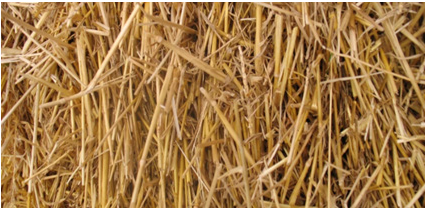
Wheat straw is the byproduct of the wheat crop produced after harvesting the wheat plants, as shown in Figure 3. The worldwide production of wheat straw is estimated to be more than 500 million tons per year. Around 50% of wheat straw is reused in soil fertilisation after harvesting, and the balance is used broadly for animal fodder, some industrial uses, and mushroom growth [33]. It contains 28-40% cellulose/hemicellulose, 20-23% moisture and 15- 25% lignin/ pith/pectin with traces of ash [34]. The wheat straw has four basic parameters for its categorisation, i.e., strength: maturity stage, internodes levels, stem diameter, and presence of moisture. A mature wheat straw of three to four level internode, 2-3mm diameter with more than 20% moisture exhibits 20-30MPa tensile strength, 5-7MPa shear strength, young modulus of 4.75-6.5GPa, and rigidity modulus of 260-550MPa [35]. These characteristics of wheat straw make it a matching suitable material for fibre-reinforced concrete, especially for enhancing the tensile and flexural properties of concrete.
Materials - Shredded fibres of PET
Polyethylene terephthalate (PET) bottles are widely used as domestic and industrial packing. They are found as a prominent waste in abundance, which needs recycling on an enormous scale. Recent studies show that 0.5-1-million-ton plastic waste is added daily, and 20,000 PET bottles are wasted every second [13,36]. Plastic is a prolonged degradable material and is always considered better to be recycled or reused instead of its disposal in landfills, seas, or incinerators. The shredding of PET bottles through a suitable shredder can produce plastic fibres with appropriate dimensions (Figure 4), used in concrete as a substitute for industrially produced costly polymer fibres. The PET shredded fibres of 1-5mm diameter, 50-200mm long exhibit approximately 40% ductility, the tensile strength of up to 260 MPa, the density of 1.39g/cm3, Young’s modulus of 2-2.7GPa [36]. These mechanical properties make it an excellent potential reinforcement material to overcome concrete’s tensile/flexural weakness [37].
Figure 4: PET bottles fibres, Shredded using a paper shredder.

Materials - Polypropylene Fibre (PPF)
Polypropylene is a stereognosis thermoplastic fibre transformed from an 85% propylene monomer [38]. It has good properties to be used as flexural/ tensile strength reinforcement material in concrete. Three different polypropylene fibres are used, namely monofilament, microfilament, and fibrillated fibres, as shown in Figure 5. It is a lighter material having a density of 0.9g/cm3 and exhibits near zero water absorption, 30-100% elongation, 0.2-0.5mm diameter, 10-50mm length, 3.5-10GPa modulus of elasticity, and 330-750MPa tensile strength. Zero water absorption, super elongation capacity, low density, and excellent tensile strength make it an internationally recognised/established fibre to use as an enhancer of mechanical properties of concrete at a rate of 1-2%, which is equivalent to 4-8kg/m3 addition as specified by the manufacturer [38,39].
Figure 5: Polypropylene fibres (macro & micro fibres) [39].
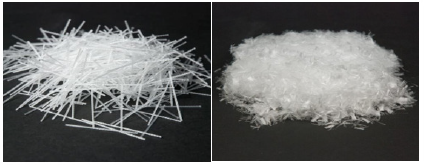
Materials - Steel fibres
Figure 6: Straight, crippled, and hooked steel fibres [41].

Steel fibres are the internationally recognised concrete reinforcement materials derived from mill cut steel sheets, recycled tires, and shredding of steel objects. A ductile, elastic, heat/crack resisting but liable to corrosion material enhances concrete’s tensile and flexural strength to a more significant extent [40]. Steel fibres broadly used in fibre reinforcement concrete are straight, crippled, or hooked fibres, as shown in Figure 6. Steel fibres of 0.2mm diameter, 10-60mm length exhibit 7800kg/m3 density, 200GPa modulus of elasticity (Young’s Modulus), and between 400-2200MPa tensile strength [41]. The manufacturer designates SF’s established/practical use at 10-17% fibres to the cement weight equivalent to 40kg/ m3 and 60kg/m3. The higher mass of SF has been used due to its higher density which is substantially greater than other fibres used in this study [42].
Materials - Concrete
Figure 7: Slump test.
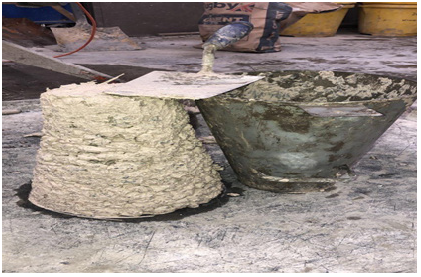
The concrete of ratio 1:2:3 has been prepared in this project using Snowcrete cement CEM1 52.5 ordinary Portland white cement as a binder. The well-graded fine aggregate (river sand) from 0-10mm as per BS-882/12620: 2008 [43] and well-graded coarse aggregate of natural crushed stone from 5-37.5mm as per BS-888 with water/cement ratio of 0.5 maintaining a minimum of 10mm slump as per BS EN 12350:2019 [44] on standard slump test apparatus as shown in Figure 7. As per the workability requirements for different fibres, an appropriate superplasticiser (Pl) quantity ranges from 10 to 25ml. A sufficient plasticiser was added for each sample to ensure a compatible mix at the S1 slump.
Methodology
Figure 8: Samples casting.

In this project, cubes (100 x 100mm) for compressive strength, cylinders (150mm diameter and 300mm height) for split tensile strength, and prisms (100 x 100 x 500mm) have been cast and water cured (Figure 8) for each mix with 1:2:3 ratio and 1-2% fibre quantities as given in Table 1. No established dosages of coir and WSF have been designated, so the dosage of coir and WSF was used as 60g and 120g, which corresponds to 1% and 2% of the cement weight in samples COF 1 & 2 WSF 1 & 2, respectively. Researchers/ manufacturers have already established the suitable dosage of polypropylene with micro fibre of 0.91kg/m3 and macrofibre from 4-8kg/m3. Therefore, PPFC 1 contains fibre ratios equivalent to 4kg/m3 of macro fibre, and PPFC 2 has 8kg/m3 of macro fibre; both PPFC1 and PPFC2 contain the same amount of 15.5g of micro fibre, and 68g and 136g macrofibres at almost 1% & 2% of cement weight. No established quantity of PET shredded fibres has been found, so quantities have been used as 60g and 120g as 1% and 2% of cement weight in line with PPFC as both are thermoplastic polymers. Researchers/manufacturers established suitable dosage of steel as 40kg/m3 - 60kg/m3; therefore, the quantities of SF at a rate of 680g and 1020g as 10% and 17% of cement weight have been used in SFC1 and SFC2. No fibres were added to the control mix. The moulds were cast using a vibratory machine to avoid porosity and facilitate compaction. These fibres were placed randomly with other FRC ingredients, but rigorous mixing resorted to better fibres distribution.
Table 1: Mix ratios and quantities of fibre, water, and plasticisers for the preparation of FRC samples.
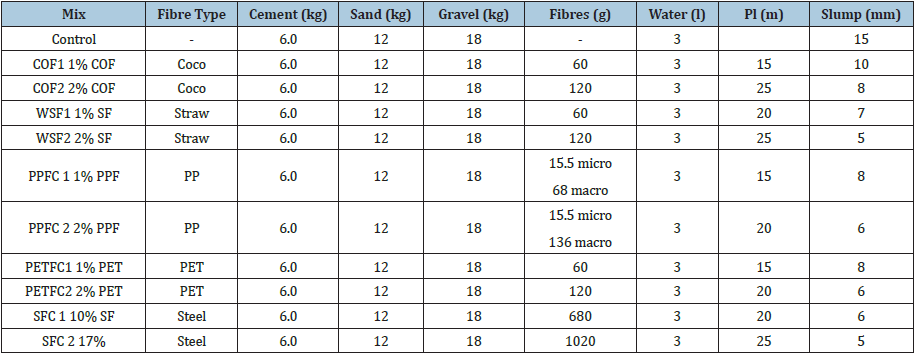
Figure 9: Cubes testing for compressive strength.

Cubes were tested at 7 and 28 days for compressive strength following BS EN 12390-3:2019 [45] using a standard compression testing machine, as shown in Figure 9. Compressive strength was calculated by the expression “P/A,” where P is load in N and A is the cross-sectional area of the cube in mm2. Each cylinder was tested for checking split tensile strength as per BS EN 12390-6:2009 [46]. A compressive load of 400N/sec was applied on the longitudinal axis, i.e., the length of the cylinder till it fractured, as shown in Figure 10. The maximum load recorded at the failure of the cylinder was used to determine the specimen’s tensile strength using the expression “2P/πDL” (where P is the maximum load in newtons ‘N’, D is diameter, and L is the length cylinder in mm). Each prism was tested for flexural strength using a three-point flexural testing machine as per BS EN 12390-5:2019 [47], as shown in Figure 11. The prism is supported on two steel rollers (400mm apart). The samples were then gradually loaded from the flexural testing machine. The maximum load at failure was then noted. Additionally, deflection, fracture surfaces, and other unique features observed during the test were recorded for qualitative comparison of the ductility of FRC samples. The flexural strength (MPa) of the prism was then calculated using the formula “3FL/2bd2” (where ‘F’ is the maximum load in ‘Newtons,’ ‘L’ is span length, ‘b’ and ‘d’ are the cross-sectional dimensions of prism in mm).
Figure 10: Cylinder testing for splitting tensile strength.

Figure 11: Prism testing for flexural strength.
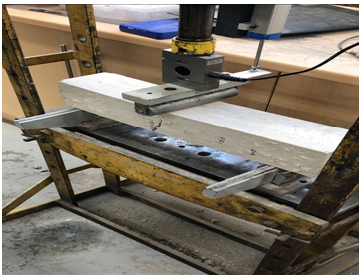
Results and Discussion
The addition of fibres resulted in decreased values of the slump and increased use of plasticisers for each mix when fibres increased from 1% to 2%. It means the workability of concrete reduces with the fibres, as shown in Table 1 & Figure 12. Zero slumps were observed without adding a plasticiser. An increase of 50-70% in plasticisers (20-25ml) and a reduction of 30-50% slump value (slump less than 10mm) was observed with 2% use of different fibres. The phenomenon was pronounced for SF and WSF due to fibre texture, length, aspect ratio, water absorption, and volume. It can be inferred that type, quantity, and aspect ratio of the fibre reduces the workability of FRC, and these findings support the existing research [48].
Figure 12: FRC workability (slump) and adding plasticisers.
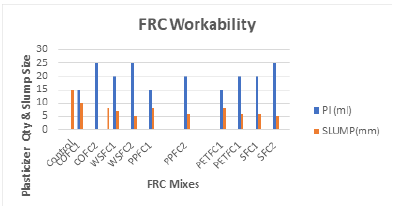
Compressive strength
Figure 13: Compressive strength of FRC mixes at 7 & 28 days (values show strength at 28 days).

The compressive strength is one of concrete’s essential primary mechanical properties [48,49]. All FRC mixes have improved compressive strength by 9-44% with different fibres compared to the control mix at 28 days of curing, as shown in Figure 13. However, the compressive strength was observed to decrease with the increase of fibres from 1-2%. The decrease in strength with more quantity of fibres is due to a reduction in bonding between the aggregates and binder, increased porosity, and reduction in composite density due to fibres distribution/ surface contact among the ingredients of concrete. This porosity and reduced bonding create weak zones inside the composite and make it more susceptible to crack propagation and weakening in strength. The optimum compressive strength, 44% more than the control mix, was obtained using 2% coir contents. The study revealed that fibres’ optimum value to get maximum compressive strength is less than 2%. Compressive strength of 1 and 2% Coir, WSF, and PPF were found equivalent to 10 and 17% use of SF. However, WSF showed less compressive strength improvement than other fibres. l Therefore, this study suggests an optimum quantity of 1-2% fibres be used in FRC composites.
Split tensile strength
The split tensile strength of concrete is another critical parameter that has remained a grey area with concrete as it is good in compression but does not perform well against tensile failure [50]. All the samples exhibited improved tensile strength and ductile failure instead of splitting failure due to the use of different fibres from 1-2%. The optimum quantity of 2% fibres showed promising results, and an improvement of up to 48% was observed with 2% fibres at 28 days strength compared to the control mix having no fibres, as shown in Figure 14. 2% use of WSF exhibited the same tensile strength as demonstrated by 17% use of SF. Therefore, the treated wheat straw fibre in FRC is suggested for higher tensile strength. The fibres’ inbuilt tensile strength, elasticity, and swelling properties improve split tensile strength by giving resilience to concrete against failing in tension. However, in the same instance, the increased number of fibres also weakens the composites due to porosity, lack of surface bonding/ contact, uneven distribution, and reduced density, which creates weaker zones and results in minor improvement/ decrease in tensile strength. FRC is suggested as an economically viable and eco-friendly option against the propagation of surface cracks and tensile cracks by behaving like reinforcement bars for a lesser strength requirement merely at the exact cost of plain concrete.
Figure 14: Split tensile strength of FRC at 28 days.
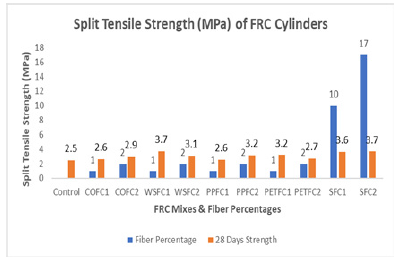
Flexural strength
Flexural strength is among the most important mechanical properties of concrete, which is used to indirectly assess the tensile behaviour of concrete structural elements when subject to bending loading [51]. Plain concrete is weak in tension and exhibits rigid rupturing under bending force. Current research has explored fibres as a cheaper solution to impart ample flexural strength to fibre concrete composites. In this study, all the samples with different fibres improved up to 42% flexural strength with 1% fibres and 10% steel fibres, as shown in Figure 15. All the samples of fibre composites exhibited higher flexural strength than the control mix. However, flexural strength decreased with increased fibre from 1-2% and steel fibres from 10% to 17%, suggesting 1% fibres and 10% SF as optimum dosage quantities, respectively. Therefore, the recommended quantity of fibre is suggested to be 1% and 10% SF. The decrease in strength with more quantity of fibres is due to uneven distribution, reduced bonding/ surface contact among the ingredients of concrete (between the aggregates and binder), increased porosity, and reduced density of composites due to the use of lightweight fibres. This porosity and reduced bonding create weak zones inside the composite and make it more susceptible to crack propagation and weakening in flexural strength. Coir fibres showed the best improvement, wheat straw, steel fibres, PET bottles fibres, and PPFC. PET shredded fibres of plastic bottles have performed better than the costlier PPF. They exhibited higher flexural strength values than that of PPFC, so it can be considered a more sustainable alternative for polymer fibres in concrete. Coir and wheat straw have also performed well and can be suggested as a suitable material for fibre-reinforced composites.
Figure 15: Flexural strength of FRC mixes at 28 days.
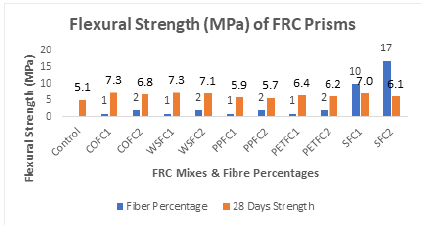
Energy absorption and post crack ductility
Flexural strength is the tangible property to withstand crack or bending when subject to a bending force. The material layers under bending pressure undergo a complex combination of bending tensile force at the top layers, no stress is experienced at the neutral axis, and compressive stress is applied at the bottom layers [51]. More quantity of fibres improves the tensile capability of fibre composites but at the same time creates weaker zones due to a lack of bonding in ingredients and results in lesser compressive strength, which cracks the bottom layers of prism under bending load. However, fibres and their natural elastic property hold the prism to crack swiftly and absorb energy even after the crack, thus exhibiting a good ductility [52,53]. All the samples with fibres have shown good ductility and energy absorption capability of fibre composites even after crack. Samples with 2% fibres showed maximum ductility. A qualitative analysis was conducted by visually observing the crack pattern and ductile behaviour of all-fibres mixes (post-testing pictures of ruptured prisms given in Figures 16-30) and plotting the flexural strength versus the displacement, which showed how long the sample absorbs energy after crack and remains intact due to the fibres. Based on their post crack ductility behaviour, the samples were categorised as brittle, moderately ductile, highly ductile, and exceptionally high. The control mix was brittle with no ductility (Figure 16). The load-displacement graphs in Figures 16-33 show the control mix and prisms with fewer fibres cracked abruptly without further displacement and energy absorption. Figures 16-33 show that all the prisms absorbed load on the application before getting cracked which represents the flexural strength and is shown in the graph by the peak of the curve. After, cracking, more ductile mixes induced due to elasticity of fibres, exhibited post crack ductility by taking the load for considerable displacement/ widening of crack before getting fully ruptured under three-point loading of prisms. This post crack ductility has been shown in graphs produced using MS Excel, by the extended length of the curves on the x-axis by linear automatically selected displacement values using thousands of auto-generated readings for flexural strength and displacement. Table 2 and Table 4 in Appendix ‘A’ further elaborate on the post crack ductility behaviour of different fibre mixes.
Figure 16: Flexural strength of FRC mixes at 28 days.

Figure 17: Prisms after crack.
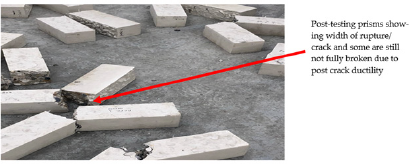
Figure 18: COF1 mix load-displacement graph.
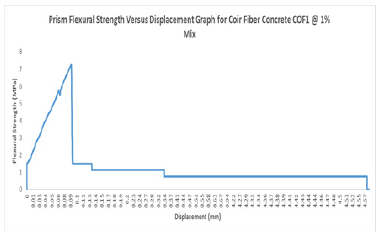
Figure 19: COF1 Prism after crack.
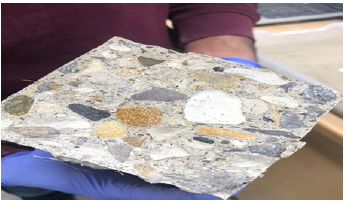
Figure 20: COF2 mix load-displacement graph.
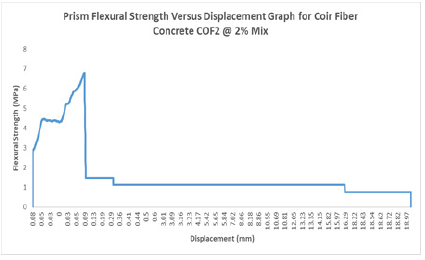
Figure 21: COF2 Prism after rupture.
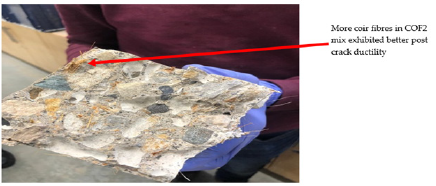
In contrast, some samples with more fibres exhibited good energy absorption even after cracking and remained intact or hanging due to the fibre ductility (Figure 17). The load-displacement graphs and post crack pictures of all samples are shown in Figures 16-33, Table 2 and Appendix A; Table 4 with the categorization of post crack ductility. The natural fibres of coir and wheat straw gave better strengths. Still, they were outperformed by synthetic plastic/ polymer materials and steel fibre in exhibiting elasticity for better bending energy absorption and post crack ductility even after crack. Steel performed the best in absorbing bending forces and showing ductility/elasticity as expected, followed by PPFC. However, PET bottles’ shredded fibre has exhibited high ductility and can be suggested as an alternative to SF and PPF for absorbing bending forces and showing ductility/elasticity.
Figure 22: WSF1 mix load-displacement graph.
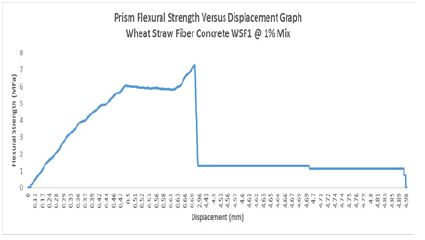
Figure 23: WSF2 mix load-displacement graph.

Figure 24: PPF1 mix load-displacement graph.
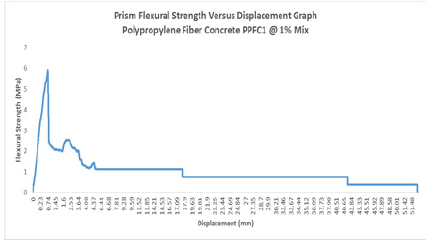
Figure 25: PPF1 Prism after rupture.
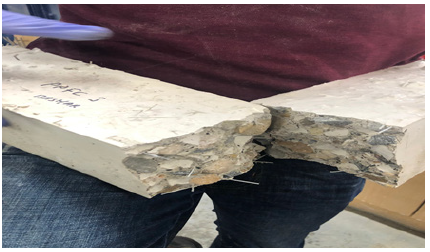
Figure 26: PPF2 mix load-displacement graph.

Figure 27: PPF2 Prism following failure.
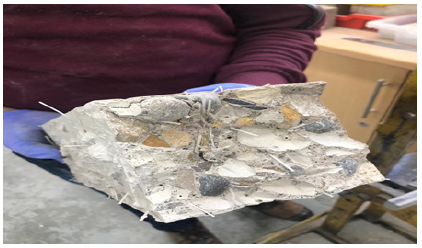
Figure 28: PETFC1 mix load-displacement graph.

Figure 29: PETFC2 mix load-displacement graph.
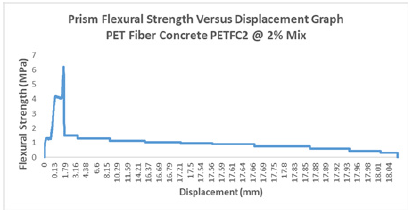
Figure 30: SF1 mix load-displacement graph.
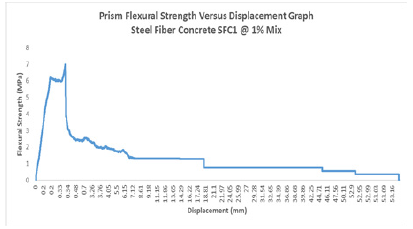
Figure 31: SF1 Prism after rupture.

Figure 32: SF2 mix load-displacement.
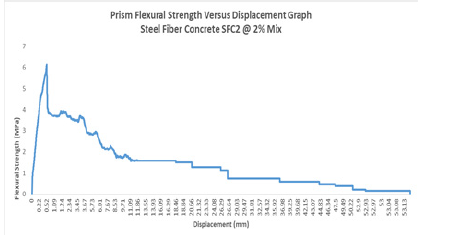
Figure 33: SF2 Prism after crack.
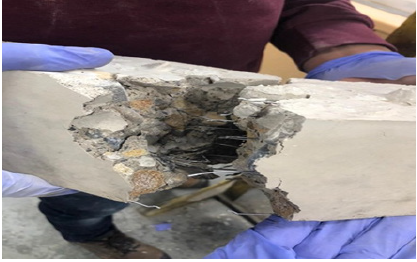
Table 2: Summary of flexural strength (MPa) and displacement.

Empirical relationship between compressive strength and tensile/flexural strength
An empirical relationship can be drawn by plotting tensile and flexural strengths versus compressive strengths of all FRC samples to evaluate the values of the mechanical properties concerning compressive strength, as shown in Figures 34 & 35 and Table 3. It can be transpired from the empirical relationship that generally; we are achieving tensile strengths equal to 5%-7.25% of the compressive strength using the empirical model/equation of trendline y = 0.0155x + 2.2585 with an R2 value of 0.041. Similarly, we get the flexural strength of 10%-12.5% of the compressive strength using the empirical model y = 0.0383x + 4.4224 with an R2 value of 0.1032. These empirical models can further elaborate the strength relationship/values for different percentages/ratios of FRC mixes for statistical analysis, which can be helpful in future studies of FRC composites.
Figure 34: Empirical Relationship between Tensile & Compressive Strength of FRC.

Figure 35: Empirical Relationship between Flexural & Compressive Strength of FRC.
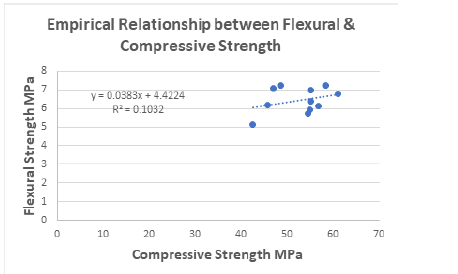
Table 3: Empirical relationship between compressive strength and tensile/flexural strength.
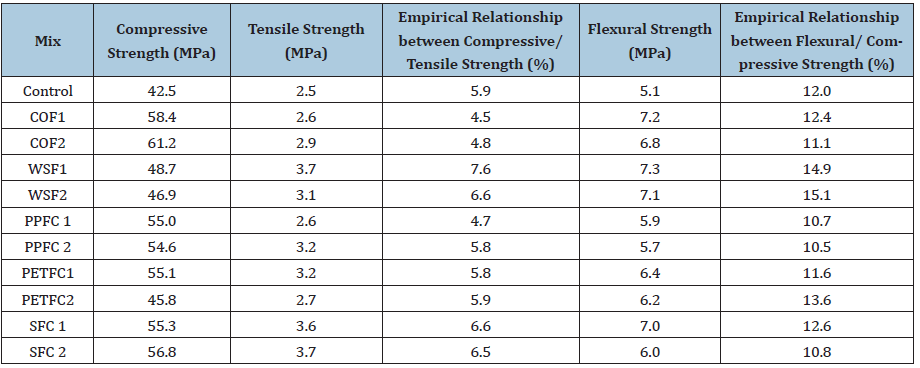
Conclusion
The main objective of this research was to evaluate the potential
of utilising fibres derived from waste in concrete; the FRC
was based on straw (WSF), coir (COF), and shredded plastic bottles
(PETF). The effect on workability and strengths (compressive,
tensile, and flexural) were evaluated and compared with the established
FRCs based on steel (SF) and polypropylene (PPF). Based on
the preliminary findings from this study, it can be concluded that
the waste fibres can be considered sustainable and economical alternatives
at par with SF and PPF to enhance the mechanical properties
of FRC. It is suggested that the straw and coir fibres are added
as a percentage of cementitious content, and the addition of waste
plastic PET fibres is based on the recommended dosage for polypropylene
as both materials are thermoplastic polymers; however,
they can also be added as a percentage of cement content to facilitating
design mix considerations. As per the established FRCs, the
addition of coir, straw, and plastic fibres reduces workability; thus,
plasticisers are required to attain a workable, compact-able, and
pumpable mix on site. Like PP and SF, adding straw, coir, and plastic
fibres enhanced the compressive, tensile, and flexural strengths.
As per this study, the optimum percentage of fibre use (COF,
PETF & WSF) is suggested to be 1% for best results with a maximum
threshold of 2%. Incorporating these fibres improved all the
aforementioned mechanical properties by nearly 50%. Furthermore,
the post crack ductility behaviour was significantly enhanced
by incorporating these waste fibres, showing the material’s capacity
to absorb bending energy even after failure. The empirical modelling
prepared by the relationship of compressive strength and other
mechanical properties is a good tool for statistical analysis/ evaluation
of strength parameters of FRC composites. The use of natural
and industrial waste fibres can be suggested as a sustainable and
economical alternative material to prevent surface cracks propagation
and enhance the mechanical properties of concrete, which can
befittingly recycle or dispose of the waste most efficiently, thus contributing
to a circular economy. Their use is particularly applicable
in the developing world, where the selection of structural materials
is governed primarily by economic constraints.
Appendix A
This appendix contains Table 4, which further comments on the post crack ductility categorisation on the load-displacement graphs, and post crack pictures of all samples are shown in Figures 16-33.
Table 4: Further comments on the categorisation of post crack ductility on the load-displacement graphs of all samples are shown in Figures 16-33.
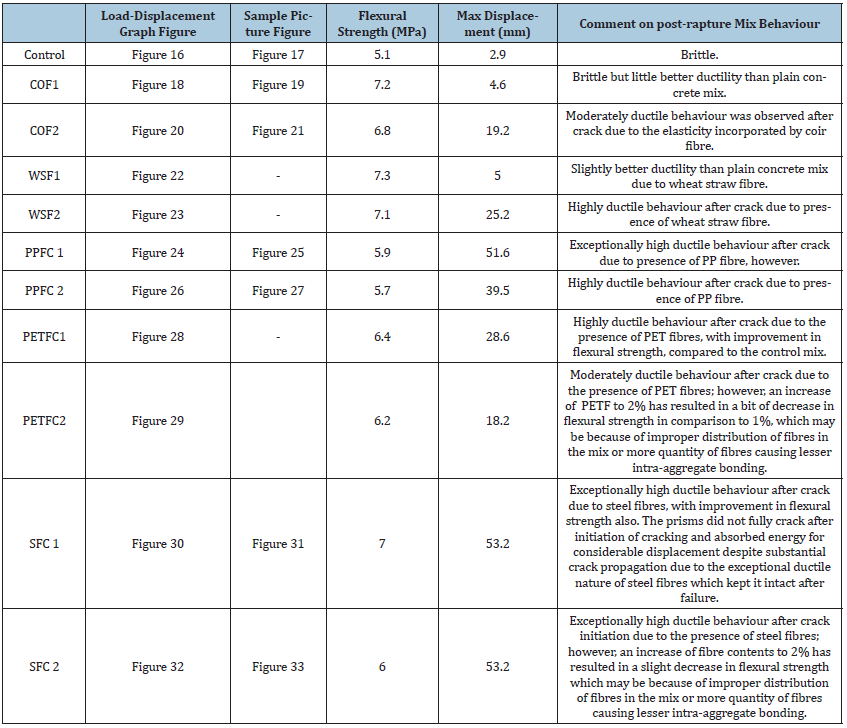
References
- Courland R (2011) Concrete planet: the strange and fascinating story of the world's most common artificial material. Prometheus Books: Amherst, NY, USA.
- Britannica (2020) The Editors of Encyclopedia. Concrete, Encyclopedia Britannica.
- (2020) Encyclopedia Britannica. Building construction: The invention of reinforced concrete.
- Condit CW (1968) The first reinforced-concrete skyscraper: The ingalls building in cincinnati and its place in structural history. Technology and Culture 9(1): 1-33.
- Richard WS (2021) History of Concrete (PDF), The Aberdeen Group, 1995.
- Morgan W (2021) Reinforced Concrete. The Elements of Structure, 1995.
- (2015) Department of Civil Engineering. History of Concrete Building Construction, CIVL 1101 - History of Concrete. The University of Memphis, USA.
- Thomas BS, Gupta RC (2013) Mechanical properties and durability characteristics of concrete containing solid waste materials. J Clean Prod.
- Shahbaz PS, Faraj RH (2020) Feasibility study on the use of shell sunflower ash and shell pumpkin ash as supplementary cementitious materials in concrete. Journal of Building Engineering 30: 101271.
- Shahbaz PS, Tajara MK, Faraj RH, Mosavi A (2021) Studying the C-H crystals and mechanical properties of sustainable concrete containing recycled coarse aggregate with used nano-silica. Crystals 11(2): 122.
- Abbasi S, Jannaty MH, Faraj RH, Shahbaz PS, Mosavi A (2020) The effect of incorporating silica stone waste on the mechanical properties of sustainable concretes. Materials 13(17): 3832.
- Onuaguluchi O, Panesar DK (2014) Hardened properties of concrete mixtures containing pre-coated crumb rubber and silica fume. J Clean Prod 82: 125-131.
- Hoornweg D, Bhada-Tata P (2021) What a waste: a global review of solid waste management. World Bank 2012, Environment_Waste_production_must_peak_this_century.
- Guerrero LA, Maas G, Hogland W (2013) Solid waste management challenges for cities in developing countries. Waste Manag 33(1): 220-232.
- Brandt AM (2008) Fibre-reinforced cement-based (FRC) composites after over 40 years of development in building and civil engineering. Compos Struct 86(1-3): 3-9.
- Al-Salem SM, Lettieri P, Baeyens J (2009) Recycling and recovery routes of plastic solid waste (PSW): A review. Waste Manag 29(10): 2625-2643.
- Akca KR, Çakir O, Ipek M (2015) Properties of polypropylene fibre reinforced concrete using recycled aggregates. Construct Build Mater 98: 620-630.
- Yildirim G, Saharan M, Ahmed HU (2015) Influence of hydrated lime addition on the self-healing capability of high-volume fly ash incorporated cementitious composites. J Mater Civ Eng 27(6): 04014187.
- Qadir HH, Faraj RH, Sherwani AFH, Mohammed BH, Younis KH (2020) Mechanical properties and fracture parameters of ultra-high performance steel fibre reinforced concrete composites made with ex-tremely low water per binder ratios. SN Applied Sciences 2(9): 1-12.
- Mohammed BH, Sherwani AFH, Faraj RH, Qadir HH, Younis KH (2021) Mechanical properties and ductility behavior of ultra-high performance fibre reinforced concrete: effect of low water-to-binder ratios and micro-glass fibres. Ain Shams Engineering Journal.
- Mohammadi Y, Carkon-Azad R, Singh SP, Kaushik SK (2009) Impact resistance of steel fibrous concrete containing fibres of mixed aspect ratio. Construct Build Mater 23(1): 183-189.
- Saikia N, De Brito J (2012) Use of plastic waste as aggregate in cement mortar and concrete preparation: a review. Construct Build Mater 34: 385-401.
- Ismail ZZ, Al-Hashmi EA (2008) Use of waste plastic in concrete mixture as aggregate replacement. Waste Manag 28(11): 2041-2047.
- Ahmed HU, Faraj RH, Hilal N, Mohammed AA, Sherwani AFH (2021) Use of recycled fibres in concrete composites: A systematic comprehensive review. Composites Part B 215: 108769.
- Rajkumar MR (2017) Recent advances in materials, mechanics and management. Proceedings of 3rd Conf. Mater. Mech. Manag., Trivandrum, India, p.450.
- (2017) Ministry of MSME India, 63rd Annual report Coir Board, New Delhi, India.
- How coir is made - material, making, history, used, processing, product, industry, machine.
- Satyanarayana KG, Kulkarni AG, Rohatgi PK (1981) Structure and properties of coir fibres. Regional research laboratory, Trivandrum. Proc Indian Acad Sci (Eng Sci) 4(4): 419-436.
- Stefanidou M, Papachristoforou M, Kesikidou F (2016) Fibre reinforced lime mortars. Proceedings of 4th Historic Mortars Conference, Greece.
- Keerthi GBS, Easwara GLP, Velmurgan R (2015) Probabilistic study of tensile properties of coir fibre reinforced polymer matrix composite. International Journal of Advanced Materials Science 6(1): 7-17, Research India Publications.
- Ahmed A, Nadir HM (2020) Use of coir in fibre reinforced concrete, soil and lime. Journal of Modern Approaches on Material Science. Lupine Publishers.
- Sutton K, Rayan W (2020) Erosion control and slope stabilization using coir. Washington University Publications and Research.
- Tufail T, Saeed F, Afzaal M (2021) Wheat straw: A natural remedy against different maladies. Food Science & Nutrition 9(4): 2335-2344.
- Ruiz HA, Ruzene DS, Silva DP, Teixeira JA (2011) Evaluation of a hydrothermal process for pretreatment of wheat straw-effect of particle size and process conditions. Journal of Chemical Technology & Biotechnology 86(1): 88-94.
- O'Dogherty MJ, Huber JA, Dyson J, Marshall CJ (1995) A study of the physical and mechanical properties of wheat straw. Journal of Agricultural Engineering Research 62(2): 133-142.
- Laville S (2021) Single-use plastics a serious climate change hazard, study warns.
- (2020) Phoenix Technologies materials properties of PET fibres.
- Adfil construction fibres. Properties of Poly-propylene by Synthetic Fibres.
- Singh SK (2016) Polypropylene fibre reinforced concrete: An overview. Retrieved from Structural Engineering Division, Central Building Research Institute.
- Barros JAO (2011) Steel fibre reinforced concrete: Material properties and structural applications. Fangueiro R (Ed.), In Woodhead Publishing Series in Textiles, Fibrous and Composite Materials for Civil Engineering Applications, Woodhead Publishing, UK, pp. 95-155,
- Tariq N, Al-Shafi HT, Ridha M, Abduljalel S (2017) An experimental investigation on the pullout strength of straight steel bars in high-performance concrete.
- Becaert materials design with SF.
- (2008) BS EN 880 revised 12620. Specification for aggregates from natural sources for concrete published by BSI.
- (2020) BS EN 12350-2:2019 TC. Testing fresh concrete. Slump-test, published by BSI.
- (2020) BS EN for BS EN 12390-3:2019 - TC. Testing hardened concrete. Compressive strength of test specimens, published by BSI.
- (2010) BS EN 12390-6:2009 TC. Testing hardened concrete. Tensile splitting strength of test specimens, published by BSI.
- (2020) BS EN 12390-5:2019 TC. Testing hardened concrete. Flexural strength of test specimens, published by BSI.
- (2019) Cement concrete & aggregates Australia. Concrete Basics A Guide to Concrete Practice.
- Neville AM, Brooks JJ (2010) Concrete Technology.
- Bahij S, Omary S, Feugeas F, Faqiri A (2020) Fresh and hardened properties of concrete containing different forms of plastic waste-A review. Waste Manag 113: 157-175.
- Yap SP, Alengaram UJ, Jumaat MZ (2013) Enhancement of mechanical properties in polypropylene and nylon–fibre-reinforced oil palm shell concrete. Mater Des 49: 1034-1041.
- Younis KH (2016) Mechanical performance of concrete reinforced with steel fibres extracted from post-consumer tires. Proceedings of 2nd International Engineering Conference on Developments in Civil and Computer Applications. IEC.
- Martinelli E, Caggiano A, Xargay H (2015) An experimental study on the post-cracking behavior of hybrid industrial/recycled steel fibre-reinforced concrete. Construct Build Mater 94: 90-298.
© 2022 Ash Ahmed. This is an open access article distributed under the terms of the Creative Commons Attribution License , which permits unrestricted use, distribution, and build upon your work non-commercially.
 a Creative Commons Attribution 4.0 International License. Based on a work at www.crimsonpublishers.com.
Best viewed in
a Creative Commons Attribution 4.0 International License. Based on a work at www.crimsonpublishers.com.
Best viewed in 







.jpg)






























 Editorial Board Registrations
Editorial Board Registrations Submit your Article
Submit your Article Refer a Friend
Refer a Friend Advertise With Us
Advertise With Us
.jpg)






.jpg)














.bmp)
.jpg)
.png)
.jpg)










.jpg)






.png)

.png)



.png)






